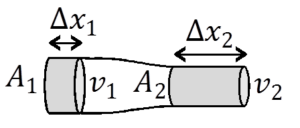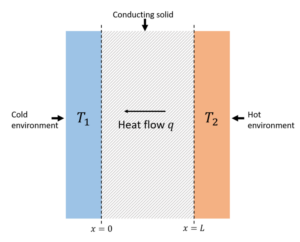The term “Boiling characteristics” and boiling characteristics related conditions will be prate in this article. Boiling is a very quick vaporization condition for any liquid substance when it reaches to boiling point.
10+ Boiling Characteristics in a mini channel is listed below,
- Specific heat
- Cross sectional area
- Temperature
- Volumetric flow rate
- Mass flow rate
- Thermal conductivity
- Heat transfer coefficient
- Heat flux
- Density
- Pressure drop
Specific heat:-
Specific heat can be deriving as; the amount of heat is needed to raise the temperature of one gram of a matter by one Celsius degree. The units of the specific heat are such as calories or joules per gram per Celsius degree.
Specific heat is also known as massic heat capacity. As an example, the specific heat of water is 1 calorie (or 4.186 joules) per gram per Celsius degree.
Formula:-
The formula for the specific heat is,
Where,
Q = Heat energy is absorbed by a substance
m = Mass of a substance
c = Specific heat capacity of a matter which is depend upon the material of the matter
ΔT= Change in temperature

Image Credit – Wikipedia
Cross sectional area:-
The term cross sectional area in geometry is defined as; the shape is carry by the intersection of the surface of a solid substance. The cross sectional area is present in three dimensional shape is a two dimensional shape of the geometry. In other way cross sectional area is that, the shape is can get through cutting rigid parallel to the foundation.
Types of cross sectional area:-
The cross sectional area can be classified in two sections,
Vertical cross sectional area
Horizontal cross sectional area

Image Credit – Wikipedia
Temperature:-
For a material temperature represent a physical quantity which helps to understand the state of the matter. Temperature can measure with the help of thermometer. In body temperature and heat both are not same physical parameter.
The physical parameters which are affect temperature such as, thermal conductivity, strength, corrosion, solubility, density vapour pressure and many more.
When the temperature is increases that time the boiling of a matter is also increases and if the temperature is decreases that time the boiling of a matter is also a decrease.

Image Credit – Wikipedia
Volumetric flow rate:-
In the field of engineering and physics volumetric flow rate is widely used. Another form of the volumetric flow rate is fluid flow rate or volume flow rate.
Inside of a pipe or a channel, the volume of the liquid substance is moving through a cross sectional area of the pipe or channel in a particular fixed time period at some standard condition where the temperature and pressure is remains unchanged.
In another word we could express that, the volumetric flow rate is the ratio between the changes of volume with the change in time.
Formula:-
The formula of the volumetric flow rate in piping system is,
Volumetric flow rate = (Flow velocity of the liquid substance) *(Cross sectional area of a pipe or a channel)
The mathematically form of the volumetric flow rate of the piping system is,
Q = vA
Where,
Q = Volumetric flow rate of a liquid substance
V = Velocity of a liquid substance
A = Cross sectional area through which fluid is flow by a open system

Mass flow rate:-
Mass flow rate can be defined as the molecules present in the liquid substance are flow through in a given cross sectional area in a fixed time period at standard condition.
Formula:-
The formula of mass flow rate is,
Mass flow rate = (Density of the fluid)* (Velocity of the liquid)* (Cross sectional area)
The mathematical form of the mass flow rate is, ṁ = dm/dt
Where,
ṁ= Rate of the mass flow for the fluid substance
dm = Change in mass
dt = Change in time
Thermal conductivity:-
Thermal conductivity states that the rate at which heat is transferred through a given material is proportional to the negative value of the temperature gradient. And it is also proportional to the area through which the heat flows, but inversely proportional to the distance between the two isothermal planes.
The formula for the thermal conductivity is,
K = Qd/AΔT
Where,
K = Thermal conductivity of a matter and unit is Watt m-1K-1
Q = The net quantity of heat transfer by a material and unit is Watts or Joules/second
d = Distance by the two planes which are isothermal
A = Area of the surface and unit is square meters
ΔT= Temperature difference and unit is Kelvin

 across a temperature difference;
across a temperature difference; Image Credit – Wikipedia
Heat transfer coefficient:-
Heat transfer coefficient can be deriving as, the amount of heat can be passes through in a system per unit area in a fixed time period. For this reason the space in added in the equation of heat transfer coefficient which is express the space over which the total amount of heat transfer of heat included.
The overall rate of the heat transfer for mixed modes can be express as in the form of an overall heat transfer coefficient or overall conductance. In this case the rate heat transfer can be express as below expression,
Q̇ = hA(T2-T1)
Where,
Q̇ = Heat transfer rate
h = Heat transfer coefficient and unit is watt per square meter Kelvin
A = Area of the surface through which heat transfer is happened and unit is square meter
T2= Surrounding fluid temperature and unit is Kelvin
T1= Solid surface temperature and unit is Kelvin
Formula:-
The general equation for the heat transfer coefficient is given below,
h = q/ ΔT
Where,
h = Heat transfer coefficient and unit is watt per square meter Kelvin
q = Heat flux and unit is Watt per square meter
Thermal power through unit area express as, q = dQ̇/dA
ΔT= The temperature difference by the surrounding area of the fluid and surface of the solid and unit is Kelvin
Heat flux:-
The term heat flux has both magnitude and direction for this reason heat flux is a scale of vector. The S.I. unit of the heat flux is watts per square metre.
The heat flux or thermal flux can be derive as, the amount of heat flow density, rate of heat flow intensity or heat flux density is a expression of flow of energy of a particular space in a fixed time.
Law of Fourier’s in one dimension:-
The total heat flux can be determined from Fourier’s law. Most of the matter which is stays in solid heat is transfer from one space to another space by convection method.
Formula:-
Mathematical form of law of Fourier’s in one dimension is given below,
φq = -K (dT(x)/dx)
Where,
k = Thermal conductivity
In the equation the negative sign represent that flow of the heat direction is from lower side to higher side.

Image Credit – Wikipedia
Density:-
The density of a matter can be derive as, the mass contain of the matter per unit volume. The symbol is used to express the density for a matter is \\rho.
Formula:-
The formula of the density of the fluid is below,
ρ = m/v
Where,
ρ= Density of a fluid
m = Mass of a fluid
v = Volume of a fluid
From the law of conversion of mass we get a clear concept about the density of fluid. The conversion of mass flow rates states that, the amount of the mass of a particular object cannot not be created or destroyed. The mass of a body is measured by lever balance.

Image Credit – Wikipedia
Pressure drop:-
The term pressure drop can be explain as, the dissimilation in net pressure between two points which are carried by a fluid as network. The pressure drop is appear when the frictional force is appear for the reason of resistance to flow, which is act as a fluid that it flow in a motion inside a pipe.
The pressure drop and flow rate of the fluid is dependent to each other. The pressure drop and flow rate of the fluid is directly proportional to each other means when the amount of flow rate of a fluid is increases that time the amount of pressure drop is also increases and the amount of flow rate of a fluid is decreases that time the amount of pressure drop is also decreases.
Hi..I am Indrani Banerjee. I completed my bachelor’s degree in mechanical engineering. I am an enthusiastic person and I am a person who is positive about every aspect of life. I like to read Books and listen to music.